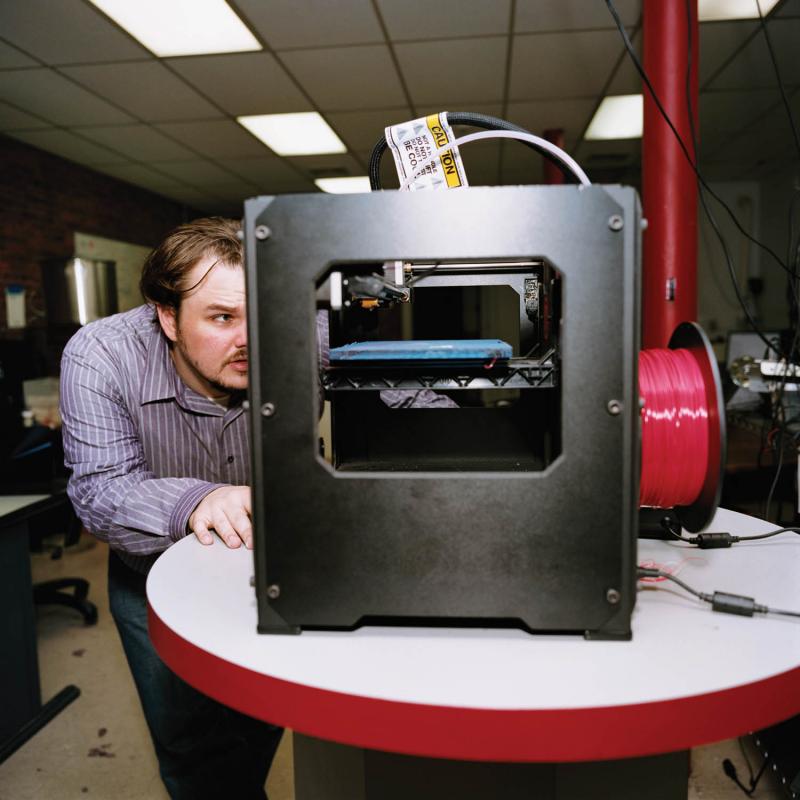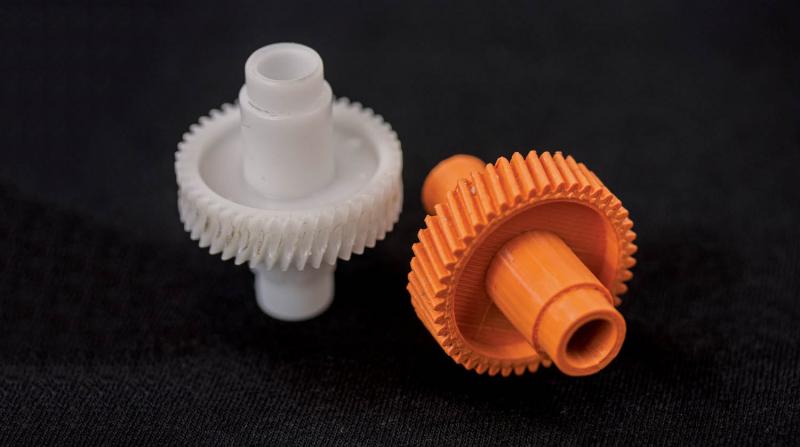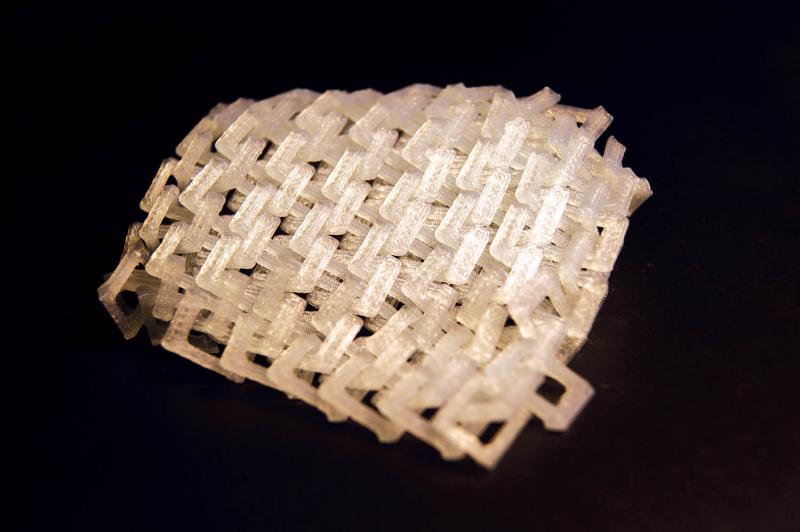On April 1, 2014, Andrew Chastain joined Jack Hitt onstage at the Institute Library in New Haven, Connecticut, as part of the ongoing series “Amateur Hour,” in which various tinkerers, zealots, and collectors discuss their obsessions. Chastain, whose day job is R&D Manager at an ink and printer manufacturer, is also a member of a New Haven hackerspace known as MakeHaven, which hosts various projects in mechanics, biology, electronics, digital art, and other disciplines. The conversation that follows was recorded live and has been edited for brevity and meaning.
Jack Hitt: Like a lot of people, I’d heard of 3-D printing and thought it was sort of neat. Then I met Andrew, and every time we talk there’s something astonishing and bizarre happening in 3-D printing. So I want to start off with something fresh in the 3-D-printing world. Tell us what we’re looking at in this video.
This is a giant 3-D printer that prints houses. It was developed by a professor at the University of Southern California who is using this fiber-reinforced, quick-drying cement and is able to print full walls. Using this in the case of, say, a disaster recovery or if you have an artistic streak and you want to design your house from scratch, this technology would allow you to take a computer-based plan, the raw material, and build the house essentially from scratch.
How long would it take to put up this house?
The numbers that the inventor came up with suggest that you could put together a 2,500-square-foot house in about twenty hours. So we’re talking about in a day you could have a new two-story house.
So have they built an actual house?
They’ve done portions of one. I don’t think they’ve finished a full structure. But they did just get a grant from NASA, because they’re also looking at how this technology would be excellent for building structures for the moon, or Mars, or any other interstellar travel where you don’t want to take a prefab unit up there because you’d have to carry all of it. Even better—let’s say, in the case of the moon—you take the rock and gravel and material already on the surface, use a binder and a 3-D printer, and send a robot to go print it before you even get there.
Tell us why we call it 3-D printing.
It’s not necessarily the best term. A broader one is “additive manufacturing.” The idea is that you could take a digital representation of an object and print it out layer by layer, building up its structure. So there are a few different technologies. One 3-D printer uses what’s called fused filament fabrication, where it takes a spool of plastic and melts it. It’s really like a very fancy hot glue gun, where it will trace and extrude this hot plastic, which then cools very quickly and makes that structure. And by building it layer by layer as you move the platform down, you are able to create a full three-dimensional object.
This is something that was first developed in the mid-1980s, but it’s been primarily used in rapid prototyping for larger groups that want to make a new steering wheel or a new gear and don’t want to have to send it off to be fully manufactured. But those printers would cost tens to hundreds of thousands of dollars. In the past four or five years, you’ve seen that price really drop. Now you can get one of these units in the $2,000 range. People are getting ones now that are a thousand or five hundred. There’s been this big shift from rapid prototyping in an engineering firm to something that you can do in your own home.
I’ve seen kids print these little plastic bulldogs and that kind of stuff. But beyond that, why would I want a 3-D printer?
Well, you can print things you couldn’t manufacture in any other way. This is a chain-mail kind of structure that’s printed as one piece. So it’s printed already, all the links attached—you just peel it off the bed and it’s there.
So that fabric is printed as one piece?
Right. And there are even printers made of more advanced materials that are able to make very durable metal pieces. And aside from the ability to make things that you couldn’t make in other ways, those methods are usually very efficient.
One cool story is that the company that made the Airbus plane has been doing research in making titanium-grade aircraft parts by 3-D printing. They’re able to use just 10 percent of the material because it doesn’t involve taking a solid block of metal and drilling out and cutting away everything. You’re just taking a bed of powder, using a laser or some other method to meld them together, and when you’re done, the leftover powder is reused. You don’t have the waste, but you’re able to make things that are just as strong. I’ve read that they’ve made parts that are 60 percent lighter and just as sturdy.
So before, you would take a large block of steel and drill out whatever you could drill out.
Right. Now they call it “subtractive manufacturing.” Traditional manufacturing is, you start with a raw piece of material, a billet of iron or whatnot, you drill it and machine it and that’s what you need to do. You have to cut away all that you don’t need, but you also have to design it and plan it so that it can be cut away. But with 3-D printing, you can just say, I need this shape to have a structure that’s going to be supporting in a certain way—you need to define it mathematically—and you can print that. Just that.
There are some structures in nature that can’t really be duplicated by traditional “subtractive” manufacturing, right? So this is opening up the possibility of entirely new structures to us?
Exactly. These are bracelets that are based upon structures like diatoms—little aquatic organisms that have these amazing structures that are very good at being strong and efficient. We’re now able to replicate that kind of thing at a much larger scale by using 3-D printing. There are even some based on cellular structures—neural connections, things like that. The technology is there to allow you to make whatever you can imagine. But there are also some very practical applications, too. I’ve found use for these things not just in my work but in my personal life.
Tell us about that.
I have an old Cuisinart hand mixer with these plastic gears inside that spin the beater. If you use the mixer on really thick dough—something that you really shouldn’t be using this on—you can burn those out, as I found. So what I did, having access to the 3-D printer, I was able to pull the little gears out and just sit down with some calipers and a CAD [computer-aided design] program and print a replica. It’s actually what’s in here now. It works. And this is one of the things we expect to see in practical use in the future. If you’ve got stuff at home that has these parts that will wear out and break, you don’t have to just throw away the whole thing.
Do you anticipate a day when you would buy your blender, and instead of a warranty you would get the CAD program for all the replacement parts?
That’s a wonderful way of using this technology. I couldn’t even find this part. I was either going to make it or throw the whole thing away.
Doesn’t that undermine the central notion of artificial obsolescence, which keeps our economy humming?
Just a little bit, yeah. It’s a big problem.
Let’s go back to the 3-D-printed house and the whole idea of having a small, at-home manufacturing plant. What kind of revolution are we talking about?
People have described it as a new industrial revolution. I don’t know if that’s overstating it or not, but it is amazing—this idea that, instead of having to buy something that someone designed, sent the plans to China, had fabricated, shipped back, and then sold through the store, I could just go online, download a file, print it myself, and have that piece with no shipping of parts, no external manufacturing. This is going to be huge. DHL, the shipping company, is a bit concerned, and they’ve been discussing the effect that at-home manufacturing’s going to have on international shipping.
So manufacturing started in these giant brick buildings that are now abandoned at the edges of cities, production that moved to other countries like China. And now you’re saying that it’s all going to move back here, but not to those brick buildings.
Well, it could. I think one model people have looked at is, instead of having a distribution network where you have your thing and you ship it to different areas, you would have small fabrication areas distributed. You could have our region’s hub, where you have some of these very high-quality printing setups, that are able to pop out these individual, customized pieces, and ship them just a short distance to you instead of having it made elsewhere.
Okay, I was joking about getting rid of artificial obsolescence, but it does seem like if that were to happen we would actually be eliminating a lot of jobs. It does seem like a huge economic concern. What are we going to do with all of this freed-up labor and freed-up time? Do you all ever think about that?
A little bit. And actually the 3-D-printed house offers an interesting point on that. The construction of a house takes a lot of people. If you have it all done by a robot, those are all people who are not doing that job. Now, on the one hand, construction is one of the most dangerous jobs. People get injured and die all the time. You can have a safer way of doing things now with this, but it’s going to require that those people are now doing something else. It is a concern.
The last seven years, one of the things we’ve heard about during the so-called “Obama recovery” is that the stock market has done well because larger companies have had a great increase in productivity, largely because of this kind of technology. But consumer spending hasn’t really changed. So the growth that’s needed for some kind of economic revival hasn’t really happened, because we haven’t figured out a way to get those people back into some kind of money-making occupation. If we’re just going to keep going further down that road—I’m making you answer that question.
It is an issue that hasn’t been resolved, and there is a bit of a class concern over who’s being hurt. But there has also been an upswing in people without much starting capital being able to start new businesses, create industries that weren’t there before. The MakerBot replicator is a good, standard machine. It’s not the top of the line—it’s also not the cheapest—but it’s about a $2,000 machine. That’s an investment that is far easier to reach than what you used to need to start fabricating these customized things. And these micro-industries are popping up more often now because of this technology. Is that enough to offset so many people losing their jobs? Probably not.
I’ve been reading a lot about the medicine stuff. I’ve read that they’ve taken stem cells and printed working organs—or have they?
They’re able to print cells. And they can print gels pretty well. They take these gels and they can put the cells in them and then build a structure—like a disc for a knee or a joint, or cartilage. They’ve even done some things with putting down layers of liver cells. But there is a big issue in that they can’t print a fully functioning organ. Because even a simpler organ has a lot of vasculature. You have to be able to have very, very thin capillaries. We’re just not at the point where we can make those kinds of structures. It’s only recently that people have printed veins. So that’s going to be a big part of it, figuring out how to print the veins, print the functional tissue of the organ. If it’s an organ that has multiple types of cells, you either have to find ways of putting stem cells down and directing how they turn into the right thing in the right area or putting the right cells in the right area. So there are some hurdles. But they have done a lot.
There’s a resident at Yale in radiology named Mark Michalski, who devised a 3-D hip, I believe, using a MakerBot first and then a larger printer. When you’re doing a hip operation, often the way it works is, you open the person up, find the fracture, and then you have different sorts of plates that you try to fit in there to see which one works best. So the patient is on the table for many, many hours. What Michalski did was use data from a CT scan to print an exact duplicate of the patient’s hip, including the fracture, down to a granular scale. Then the surgeons could hold the hip and see the fracture—see exactly what was wrong with it and create the mechanics they would need once they got in there. Now they can cut you open, put this thing in, and close you right back up. This was all just a couple of weeks ago.
And it’s not just the idea of being able to match parts. It’s also to give the doctor a chance to see what a tumor looks like, all the intricacies of the shape as it fits into the rest of the body. Before they open the patient, they can say, If I cut here, if I need to remove this … and they can show the patient what they’re going to do. It’s far better to convey this information to both the physician and the patient when you can hold it in your hand.
Could a 3-D printer print a 3-D printer?
Yes. One of the early printers that really has helped bring about the growth of these small cheap printers is what’s called the RepRap. In 2005, in the UK, a professor started a blog and started discussing the idea of making a printer—a rapid prototyper, was the early term for these—that could replicate itself, and would evolve. And they named them after various scientists and biologists. The first one was Charles Darwin, then Gregor Mendel, a few others. So any of the complicated parts—the joints, things like that—could be printed.
So since we’re in this zone of dangerous things that could happen, what are some of the other dangerous things that might happen with the 3-D printer?
I am certain at least some of you have heard about the Liberator, which was a 3-D-printed gun designed by Defense Distributed.
It was actually a handgun that we built in World War II, right? It was a very simple four, five parts. We were going to drop them on our side of Allied lines so that citizens of Denmark or whatever could just pick them up, load them, and go kill Nazis.
Right, or at the very least, there was the threat that any civilian could hold one of these zip guns. One shot, and then you have to force out the shell and reload it—you really only got one shot, and it was really inaccurate. The maximum range was twenty-five feet, so you’d have to be standing next to the person. But there was a psychological thing that you could arm citizens. Taking that name, a gun was developed that could be printed on a 3-D printer.
So did some corrupting adult encourage you to actually print one of those?
Yes.
And did you put that gun together?
I did.
Is it legal for you to have printed that gun?
So, there are instructions in the downloaded files that say that if before you put it together, you glue in a chunk of metal, it becomes a detectable firearm and is not in violation of one law. And if you print the barrel so that it’s rifled, not a smoothbore, that makes it so it doesn’t violate another law. And if you’re not selling them, and you put it together in the right way, it’s supposed to be a legal thing to print.
When you finally put the gun together, were you wearing safety gear?
Yes. We were in a firing range. We had our goggles and our ear protectors on. We were doing it with the owner of the range, who made sure we did it safely, using a vice, so we were not holding anything. We were actually standing in the next bay over with a string.
And you put in a .380 caliber shell, aimed it at a target, and pulled the string.
Right. The gun didn’t fare very well.
Though it did hit the target.
Probably less than twenty-five feet away.
But it hit him in the hip. The good news is he can go to Yale and get it fixed. Had you ever shot a gun before that day?
Never, no. Without any knowledge or experience, just downloading the file, I was able to print it. And it worked. Which is a sobering thought. It didn’t fire great, plastic shrapnel flew everywhere—
But it all shot forward. I think if you had held it in your hand you’d probably just scorch some part of your hand.
Another interesting piece about it is that Defense Distributed, the company that made this, was told to take it down. So it’s not available on their website. But they released it on the internet, which means it’s out there permanently.
So there was some attempt by the government to forbid the use of this code. And I’m not sure if this is a First Amendment issue or a Second Amendment issue, or both.
There’s an overall concern with 3-D printed objects. The gear I made, I didn’t design that gear initially. Some person at Cuisinart made that. If I were to release that file on the internet, I would then presumably be violating their copyright.
There was a lot of anxiety about the gun. But just in researching the Liberator, I came upon the fact that in the ’50s and early ’60s there was this huge panic with the zip gun, which is the same thing. You can actually fire a bullet with some homemade objects that can be found at any hardware store.
This is a more expensive version of taking a tube, a nail, and a bullet and making something with that. This isn’t an elegant weapon. But the technology, if you use anything that is not the $2,000 plastic printer, you can make a full, working gun that is the same as the one you’d purchase. There is some concern, also, with the idea that while you can maybe stop the trade or sale of firearms or particular weapons with other countries, it’s a bit harder to stop them from getting a 3-D printer and just making them. I think that’s part of what the people who came down on Defense Distributed were concerned about—putting this on the internet and thereby essentially selling weapons to enemies. You’ve given them the way now to make a weapon.
Could you print a bazooka?
I believe you could, but without some of these really fancy printers you can’t yet print gunpowder.
Just thinking about the economy again for a second, this is like what Napster did to music. This is really the Napsterization of the entire global economy in some ways. Right now, we’re printing these plastic things, but imagine if you could you take the code and print an iPhone for $50 instead of $500. We’re probably not that far away from printing some fairly expensive things that would be purchased at a store. And when you have that happening to the central idea of the modern economy—
There are people right now, economists and thinkers, who are trying to develop theories of post-abundance or post-sufficiency, where, if we could print anything, how is that going to affect the economy? If you can print a replica, prices drop. These technologies become so much cheaper, so commonplace, that anyone can have them. What does that look like? We have no idea.
One of the things that’s really interesting about this technology is that, we’re currently in this era of digitization. It’s ironic that we’re sitting here in a library where all of these books could fit on a device in your pocket. We’re trending toward the physical realm being digitized—art, music, literature, all these things are going in that direction. But this technology is the step back. This is the way you can take the digital—some of these structures are purely numeric. These are not things that someone actually went and drew. They made a formula for some geometric shape and that defined the structure. And they were then able to bring that into the real world. And in this new era, this new interaction with the digital is not just a one-way street. We’re able to bring in this data, do what we want to do with it, and bring it back into physical world.
So what you’re saying is 3-D printing is sort of taking us back home.
It completes the circle—the real world to the digital and back to the real world.










